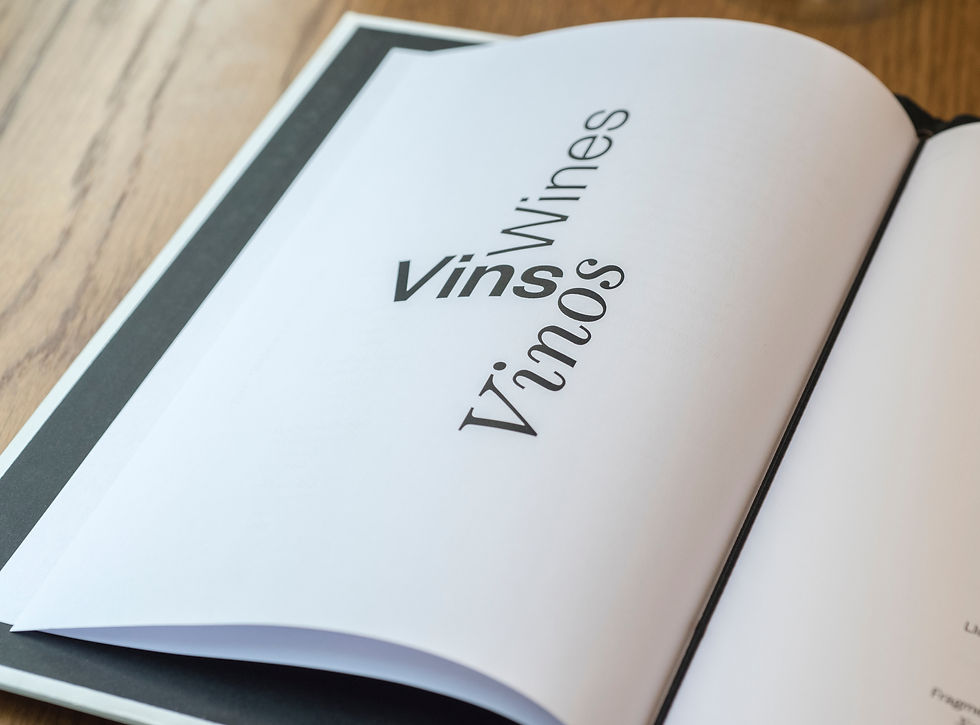Are restaurants and bars too complacent with their wine lists?
- Iván González Gaínza

- Feb 17
- 4 min read
Updated: Feb 18
As wine distributors on the island of Mallorca, we are acutely aware of how much (or how little) attention businesses pay to their wine lists. It is incredibly frustrating to see the same predictable selection of Ribera del Duero, Rioja, Albariño, and Verdejo wines appearing time and again. While these wines undoubtedly have their place, Spain - and the world - has so much more to offer.

This raises an important question:
Why do so many establishments fail to explore beyond these conventional choices?
In speaking with restaurant and bar owners, the answers are dishearteningly repetitive:
"We want to sell cheap wines that will give us a good mark-up."
"It is too hard to sell wines we know nothing about."
"We don’t have time to train our staff on how to sell wines."
"A comprehensive cocktail list is easier to sell and makes more money."
These responses reveal a reluctance to innovate and a lack of consideration for what a diverse, well-curated wine list can bring to the overall dining experience.

The Problem with Stagnant Wine Lists
Large corporations also play a role by exerting pressure on businesses to buy solely from them, offering enticing discounts, perks, funding for expenses, and even unethical incentives. Independent distributors like ourselves cannot - or choose not to - engage in such practices. The result? Wine lists that lack imagination and diversity, which is a real shame for both businesses and consumers.
Another common issue is the lack of attention restaurants pay to their wine selection compared to their food menus. Many invest tremendous effort in crafting an enticing food menu, only to neglect their wine list. A thoughtfully curated wine menu doesn’t have to be extensive, but it should reflect flair, creativity, and a connection to the cuisine being served.
It is disheartening to visit a restaurant with an inspiring food menu, only to find a wine list that feels dull and uninspired.
A Case for Innovation
One restaurateur in Ciudad Jardín recently shared his approach. While he relied on a single supplier (due to their support with providing fridges), he took the time to thoughtfully design his wine menu. Alongside the classics, he offered more unique wine options and added thoughtful touches - a brief sentence and a couple of emojis for each wine to help customers better understand their choices. His creativity and willingness to explore beyond the basics led to a significant boost in wine sales.

Why a Thoughtful Wine List Matters
As passionate wine lovers, one of the first things we do when choosing a restaurant is to review the wine list. If it lacks originality or fails to spark interest, we often opt to dine elsewhere. An exciting, thoughtfully curated wine selection enhances the meal, educates diners, and fosters a deeper appreciation for the art of wine and food pairing.
We would love to see more restaurants and bars step out of their comfort zones.
By exploring lesser-known regions, experimenting with diverse grape varieties, and training staff to confidently recommend pairings, businesses can elevate their offerings and stand out in an increasingly competitive market.

So, What Can a Restaurant or Bar Do to Increase Sales and Offer a Dynamic Wine Menu?
Here are practical steps to help businesses boost wine sales and engage customers with a more exciting wine selection:
Introduce off-menu options: If your wine menu is static or “closed” for the year, offer flexible options like daily or weekly wine specials, just as you would with food.
Offer rotating features: Introduce a “Wine of the Week” or “Wine of the Month,” and regularly update your wines by the glass to keep things fresh and exciting.
Work with multiple distributors: Avoid relying solely on one distributor to ensure variety and prevent menu fatigue for returning customers.
Stay on top of trends: Research emerging wine trends and consult your distributors for advice and recommendations on what’s new and popular.
Highlight local wines: Showcase wines made from local grape varieties and create a rotating selection of regional offerings to reflect exciting new releases from local wineries.
Consider the seasons: Adjust your wine menu seasonally, offering lighter, crisper options in warmer months and fuller-bodied wines in cooler seasons to match customer preferences.
Dessert wine pairings: When serving dessert, present a selection of sweet wines at the table to visually entice customers and enhance the dining experience with thoughtful pairing suggestions.
Offer wine flights: Provide customers with wine flight options, allowing them to sample three different wines before committing to a full glass or bottle. This encourages exploration and upselling.
Engage with your customers: Ask returning guests for feedback. Find out what they enjoy, if anything is missing from the menu, and use this insight to shape your wine offerings.
Variety is the spice of life, and by incorporating any or all of these ideas, wine menus can become more dynamic, enhance customer satisfaction, and significantly boost profits.
The question remains: Will restaurants rise to the occasion?



Comentários